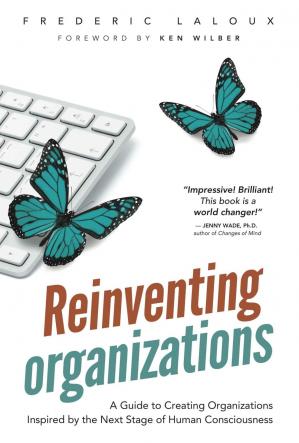Reinventing Organizations |

|
 Diese Seite wurde seit 1 Jahr inhaltlich nicht mehr aktualisiert.
Unter Umständen ist sie nicht mehr aktuell.
Diese Seite wurde seit 1 Jahr inhaltlich nicht mehr aktualisiert.
Unter Umständen ist sie nicht mehr aktuell.
 Zusammenfassungen
Zusammenfassungen
 The way we manage organizations seems increasingly out of date. Survey after survey shows that a majority of employees feel disengaged from their companies. The epidemic of organizational disillusionment goes way beyond Corporate America-teachers, doctors, and nurses are leaving their professions in record numbers because the way we run schools and hospitals kills their vocation. Government agencies and nonprofits have a noble purpose, but working for these entities often feels soulless and lifeless just the same. All these organizations suffer from power games played at the top and powerlessness at lower levels, from infighting and bureaucracy, from endless meetings and a seemingly never-ending succession of change and cost-cutting programs.
The way we manage organizations seems increasingly out of date. Survey after survey shows that a majority of employees feel disengaged from their companies. The epidemic of organizational disillusionment goes way beyond Corporate America-teachers, doctors, and nurses are leaving their professions in record numbers because the way we run schools and hospitals kills their vocation. Government agencies and nonprofits have a noble purpose, but working for these entities often feels soulless and lifeless just the same. All these organizations suffer from power games played at the top and powerlessness at lower levels, from infighting and bureaucracy, from endless meetings and a seemingly never-ending succession of change and cost-cutting programs.Deep inside, we long for soulful workplaces, for authenticity, community, passion, and purpose. The solution, according to many progressive scholars, lies with more enlightened management. But reality shows that this is not enough. In most cases, the system beats the individual-when managers or leaders go through an inner transformation, they end up leaving their organizations because they no longer feel like putting up with a place that is inhospitable to the deeper longings of their soul.
We need more enlightened leaders, but we need something more: enlightened organizational structures and practices. But is there even such a thing? Can we conceive of enlightened organizations?
In this groundbreaking book, the author shows that every time humanity has shifted to a new stage of consciousness in the past, it has invented a whole new way to structure and run organizations, each time bringing extraordinary breakthroughs in collaboration. A new shift in consciousness is currently underway. Could it help us invent a radically more soulful and purposeful way to run our businesses and nonprofits, schools and hospitals?
The pioneering organizations researched for this book have already "cracked the code." Their founders have fundamentally questioned every aspect of management and have come up with entirely new organizational methods. Even though they operate in very different industries and geographies and did not know of each other's experiments, the structures and practices they have developed are remarkably similar. It's hard not to get excited about this finding: a new organizational model seems to be emerging, and it promises a soulful revolution in the workplace.
 Bemerkungen zu diesem Buch
Bemerkungen zu diesem Buch
 Mit Fredrick Laloux’s (2014) Buch „Reinventing Organizations“, der das Modell in
abgeänderter Form nutzte, fand Spiral Dynamics eine zunehmende Verbreitung im Organisationsentwicklungsbereich
und wurde u. a. in folgenden Büchern aufgegriffen:
Oesterreich
und Schröder in „Agile Organisationsentwicklung“ (2020) und „Das kollegial
geführte Unternehmen“ (2017), Werther und Jacobs (2014) in „Organisationsentwicklung“,
Hofert in „Das agile Mindset“ (2018) und Klein und Hughes (TheDive) in „The
Loop approach“ (2019).
Mit Fredrick Laloux’s (2014) Buch „Reinventing Organizations“, der das Modell in
abgeänderter Form nutzte, fand Spiral Dynamics eine zunehmende Verbreitung im Organisationsentwicklungsbereich
und wurde u. a. in folgenden Büchern aufgegriffen:
Oesterreich
und Schröder in „Agile Organisationsentwicklung“ (2020) und „Das kollegial
geführte Unternehmen“ (2017), Werther und Jacobs (2014) in „Organisationsentwicklung“,
Hofert in „Das agile Mindset“ (2018) und Klein und Hughes (TheDive) in „The
Loop approach“ (2019). Dieses Buch erwähnt ...
Dieses Buch erwähnt ...
 Personen KB IB clear | Don Eward Beck , Christophe C. Cowan , Clare W. Graves , Gareth Morgan , C. Otto Scharmer , Peter M. Senge , Ken Wilber | |||||||||||||||||||||||||||||||||||||||||||||||||||||||||||||||
 Aussagen KB IB clear | Organisation = Maschineorganizations as machines | |||||||||||||||||||||||||||||||||||||||||||||||||||||||||||||||
 Begriffe KB IB clear | Arbeitwork
,  CO2-Fussabdruck
, Efficiency (Usability-Dimension)Efficiency
, CO2-Fussabdruck
, Efficiency (Usability-Dimension)Efficiency
,  Gesellschaft Gesellschaft society
, society
,  GREEN / HumanBond
, GREEN / HumanBond
,  Hierarchie Hierarchie hierarchy
, hierarchy
,  Industriegesellschaft Industriegesellschaft industrial age
, industrial age
,  Innovation Innovation innovation
, innovation
,  Kreativität Kreativität creativity
, creativity
,  Management Management management
, management
,  Maschine Maschine machine
, machine
,  Motivation Motivation motivation
, motivation
,  ökologischer Fussabdruck ökologischer Fussabdruck ecological footprint
, ecological footprint
,  ORANGE / StriveDrive
, ORANGE / StriveDrive
,  Problem Problem problem
, problem
,  RED / PowerGods
, ReengineeringReengineering
, RED / PowerGods
, ReengineeringReengineering
,  Serotonin
, survival of the fittestsurvival of the fittest
, Serotonin
, survival of the fittestsurvival of the fittest
,  Unternehmen Unternehmen company
, company
,  work-life-balance work-life-balance
| |||||||||||||||||||||||||||||||||||||||||||||||||||||||||||||||
 Bücher |
|
 Dieses Buch erwähnt vermutlich nicht ...
Dieses Buch erwähnt vermutlich nicht ... 
 Nicht erwähnte Begriffe | BEIGE / SurvivalSense / AN-State / Der Existierende, BLUE / TruthForce, PURPLE / KinSpirits, TURQUOISE / GlobalView, YELLOW / FlexFLow |
 Tagcloud
Tagcloud
 Zitationsgraph
Zitationsgraph
 Zitationsgraph (Beta-Test mit vis.js)
Zitationsgraph (Beta-Test mit vis.js)
 Zeitleiste
Zeitleiste
 7 Erwähnungen
7 Erwähnungen 
- Reinventing Organizations - Illustrated Invitation Edition (Frederic Laloux) (2016)

- Brave New Work - Are You Ready to Reinvent Your Organization? (Aaron Dignan) (2019)

- Wie Corona die Hochschullehre verändert - Erfahrungen und Gedanken aus der Krise zum zukünftigen Einsatz von eLearning (Ullrich Dittler, Christian Kreidl) (2021)


- Vom Krisenmodus zum agil-stabilen Management - Wie Corona die Lehre an Hochschulen verändert hat und verändern wird (Andreas Breinbauer, Eva Schiessl-Foggensteiner)


- Vom Krisenmodus zum agil-stabilen Management - Wie Corona die Lehre an Hochschulen verändert hat und verändern wird (Andreas Breinbauer, Eva Schiessl-Foggensteiner)
- New Work braucht New Learning - Eine Perspektivreise durch die Transformation unserer Organisations- und Lernwelten (Jan Foelsing, Anja Schmitz) (2021)


- Check-In (2021)


- Ein Teil des Ganzen - Perspektiven auf unser Umfeld im Wandel


- New X - Entwicklungsstufen im Wandel


- Check-In (2021)
- Digital Leadership - Schulen im digitalen Wandel führen (Tobias Röhl, Johannes Breitschaft, Eliane Burri, Nicole Wespi) (2023)


- (Digital) Learning Leadership for Change (Martin Fugmann)

- (Digital) Learning Leadership for Change (Martin Fugmann)
 Volltext dieses Dokuments
Volltext dieses Dokuments
 Anderswo suchen
Anderswo suchen 
 Beat und dieses Buch
Beat und dieses Buch
 Beat hat dieses Buch während seiner Zeit am Institut für Medien und Schule (IMS) ins Biblionetz aufgenommen. Beat besitzt kein physisches, aber ein digitales Exemplar. (das er aber aus Urheberrechtsgründen nicht einfach weitergeben darf). Es gibt bisher nur wenige Objekte im Biblionetz, die dieses Werk zitieren. Beat selbst sagt, er habe dieses Dokument überflogen.
Beat hat dieses Buch während seiner Zeit am Institut für Medien und Schule (IMS) ins Biblionetz aufgenommen. Beat besitzt kein physisches, aber ein digitales Exemplar. (das er aber aus Urheberrechtsgründen nicht einfach weitergeben darf). Es gibt bisher nur wenige Objekte im Biblionetz, die dieses Werk zitieren. Beat selbst sagt, er habe dieses Dokument überflogen.














 , 5566 kByte)
, 5566 kByte)  Biblionetz-History
Biblionetz-History